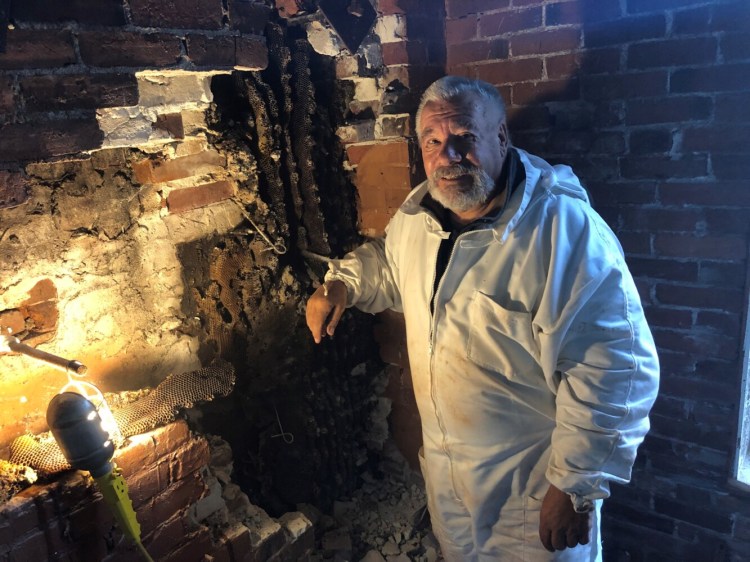HALLOWELL — Several uninvited guests created quite a buzz last week as construction work continued at the Erskine Building in Stevens Commons.
Between 60,000 and 80,000 bees were removed from their huge hive — more than 8 feet tall — in the center of 16-inch-thick exterior brick walls during work at the building destined to be a University of Maine at Augusta dormitory.
Beekeeper Larry Davis, of Hallowell, said the “monster” hive, which was about 4 feet wide, was discovered early last week between two walls. He said it was likely undisturbed for a number of years while the Erskine Building, like others at Stevens Commons, was sitting unused.
“No one has bothered them for years,” he said. “It was the perfect environment for them because it was so thick so they could maintain their heat no matter how cold it gets.”

Material extracted last week from the large beehive between two walls at the Erskine Building at Stevens Commons. Photo courtesy of Larry Davis
Davis spoke about the bees last year with Stevens Commons developer Matt Morrill. He said Morrill told him he did not want to exterminate the bees and said he would be in touch with Davis when construction began.
Davis said the bees entered the building through holes the size of quarters near the fire escape. The holes were plugged and the room was covered in plastic so bees would not escape.
Davis said he used a gentle vacuum to move the bees over three days into two large cylinders to be relocated. Davis said he thought the bees could be moved near a trailhead at Stevens Commons, but he decided against it because people may be afraid of them or disturb the hive. Davis said he took the bees to Peaks Island, where he keeps four other hives with 30,000 to 50,000 bees each.
Davis said these bees, which he thought were Italian honeybees, were some of the most gentle bees he has ever handled.

A bee from the Erskine Building at Stevens Commons.
“I took my mesh veil off because they weren’t stinging us,” he said. “Some hives are more aggressive based on their genetics.”
The Hallowell Fire Department provided assistance, lending the use of its thermal imaging camera to detect the heat being given off from the hive.
Fire Chief Jim Owens said uninhabited portions of the wall appeared cold on the camera, but the bees emitted enough heat to outline the hive with tape before contractors knocked out parts of the wall.
Owens said he had previously used the tool to camera to track lost people in the woods and during fires to determine if there was “hidden fire” behind walls.
“You never know what we’re going to call called to,” he said. “You have to be ready for anything.”
The Erskine Building will be the second residence hall at Stevens Commons after Stevens Hall, which opened in August. Local officials told the Kennebec Journal last month they were pleased with the development at Stevens Commons.
In April, The Associated Press reported more than a dozen bee species that were critical for pollinating numerous crops in New England were on the decline.
The U.S. Department of Agriculture’s Natural Resources Conversation Service said more than $15 billion of crops are pollinated each year by honeybees.
Each winter since 2006, however, 30% of hives have collapsed because of disease, parasites, poor nutrition, pesticide exposure and other issues.
Send questions/comments to the editors.




Success. Please wait for the page to reload. If the page does not reload within 5 seconds, please refresh the page.
Enter your email and password to access comments.
Hi, to comment on stories you must . This profile is in addition to your subscription and website login.
Already have a commenting profile? .
Invalid username/password.
Please check your email to confirm and complete your registration.
Only subscribers are eligible to post comments. Please subscribe or login first for digital access. Here’s why.
Use the form below to reset your password. When you've submitted your account email, we will send an email with a reset code.